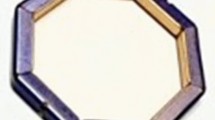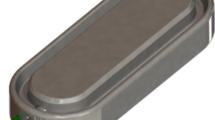Abstract
Background
Minimally invasive metabolic/bariatric surgery (MBS) may be further advanced by magnetic compression anastomosis (MCA) technology. The study aimed to develop a magnet sized to create a patent duodeno-ileostomy (DI) and verify its effectiveness in a porcine model.
Methods
Developmental study phase: magnets with 4 different flange-offset dimensions were tested to identify a design that would successfully form a compression anastomosis. Verification phase: evaluation of the selected design’s efficacy. In each 6-week phase (4 pigs/phase), one magnet was inserted laparoscopically in the jejunum, one placed gastroscopically in the duodenum. Magnets were aligned, gradually fused, formed an anastomosis, and then detached and were expelled. At necropsy, MCA sites and sutured enterotomy sites were collected and compared.
Results
Developmental phase: the linear BC42 magnet with a 2.3-mm flange offset design was selected. Verification phase: in 4 swine magnets were mated at the target location, confirmed radiographically. Mean time to magnet detachment 16.0 days (12–22), to expulsion 24.5 days (17–33). MCA was achieved in all animals at time of sacrifice. Animals gained a mean 9.5 kg (3.9–11.8). Specimens revealed patent anastomoses of ≥ 20 mm with smooth mucosa and minimal inflammation and fibrosis compared to sutured enterotomies. One pig underwent corrective surgery for a mesenteric hernia without sequelae.
Conclusion
In a large-animal model, gross and histopathologic examination confirmed that the linear MCA device created a patent, well-vascularized, duodeno-ileal anastomosis. The novel MCA device may be appropriate for use in human MBS procedures.







Similar content being viewed by others
References
Kirwan JP, Courcoulas AP, Cummings DE, Goldfine AB, Kashyap SR, Simonson DC et al (2022) Diabetes remission in the Alliance of Randomized Trials of Medicine Versus Metabolic Surgery in Type 2 Diabetes (ARMMS-T2D). Diabetes Care 45(7):1574–1583
Sarwer DB, Gasoyan H, Bauerle Bass S, Spitzer JC, Soans R, Rubin DJ (2021) Role of weight bias and patient-physician communication in the underutilization of bariatric surgery. Surg Obes Relat Dis 17(11):1926–1932
Amat C (1895) Appareils a sutures: les viroles de denans; les points de Bonnier; les boutons de Murphy. Arch Med Pharmacie Militaires Paris 25:273–285
Murphy JB (1892) Cholecysto-intestinal, gastro-intestinal, entero-intestinal anastomosis, and approximation without sutures. Med Rec N Y 42:665–676
Mayo WJ, Mayo CH (1895) Clinical report—I: Complete section of the vas deferens, end-to-end union; II: acute suppuration of knee-joint: open treatment; III: gastro-enterostomy by the murphy button: anastomoses by this method. Ann Surg 21(1):35–44
Stewart D, Hunt S, Pierce R, Dongli M, Frisella M, Cook K et al (2007) Validation of the NITI endoluminal compression anastomosis ring (EndoCAR) device and comparison to the traditional circular stapled colorectal anastomosis in a porcine model. Surg Innov 14(4):252–260
Tucker ON, Beglaibter N, Rosenthal RJ (2008) Compression anastomosis for Roux-en-Y gastric bypass: observations in a large animal model. Surg Obes Relat Dis 4(2):115–121
Gagner M, Heppell J, Lamarre L, Carioto S (1993) L’anastomose colique par laparoscopie avec l’anneau biodégradable valtrac: Une étude comparative dans un modèle canin. Ann Chir 46(9):875
Kanshin NN, Lytkin MI, Knysh VI, lu Klur V, Khamidov AI, (1984) First experience with application of compression anastomoses with the apparatus AKA-2 in operations on the large intestine. Vestn Khir Im I I Grek 132:52–57
Hardy TG, Aguilar PS, Stewart WR, Katz AR, Maney JW, Costanzo JT et al (1987) Initial clinical experience with a biofragmentable ring for sutureless bowel anastomosis. Dis Colon Rectum 30(1):55–61
Rebuffat C, Rosati R, Montorsi M, Fumagalli U, Maciocco M, Poccobelli M et al (1990) Clinical application of a new compression anastomotic device for colorectal surgery. Am J Surg 159:330–335
Bubrick MP, Corman ML, Cahill CJ, Hardy TG, Nance FC, Shatney CH (1991) Prospective, randomized trial of the biofragmentable anastomosis ring. Invest Group Am J Surg 161:136–142
Cossu ML, Coppola M, Fais E, Ruggiu M, Spartà C, Profili S et al (2000) The use of the Valtrac ring in the upper and lower gastrointestinal tract, for single, double, and triple anastomoses: a report of 50 cases. Am Surg 66(8):759–762
Nudelman IL, Fuko V, Greif F, Lelchuk S (2002) Colonic anastomosis with the nickel-titanium temperature-dependent memory-shape device. Am J Surg 183:697–701
Lee JY, Woo JH, Choi HJ, Park KJ, Roh YH, Kim KH, Lee HY (2011) Early experience of the compression anastomosis ring (CAR™ 27) in left-sided colon resection. World J Gastroenterol 17(43):4787–4792
Ye F, Chen D, Wang D, Lin J, Zheng S (2014) Use of Valtrac™-secured intracolonic bypass in laparoscopic rectal cancer resection. Medicine (Baltimore) 93(29):e224
Bobkiewicz A, Studniarek A, Krokowicz L, Szmyt K, Borejsza-Wysocki M, Szmeja J et al (2017) Gastrointestinal tract anastomoses with the biofragmentable anastomosis ring: is it still a valid technique for bowel anastomosis? Analysis of 203 cases and review of the literature. Int J Colorectal Dis 32(1):107–111
Gagner M (2021) Laparoendoscopic magnetic gastrointestinal anastomosis. In: Gagner M (ed) Magnetic surgery. Springer Publisher, New York, pp 135–148
Kaidar-Person O, Rosenthal RJ, Wexner SD, Szomstein S, Person B (2008) Compression anastomosis: history and clinical considerations. Am J Surg 195:818–826
Marrache MK, Itani MI, Farha J, Fayad L, Sharara SL, Kalloo AN et al (2021) Endoscopic gastrointestinal anastomosis: a review of established techniques. Gastrointest Endosc 93(1):34–46
Jamshidi R, Stephenson JT, Clay JG, Pichakron KO, Harrison MR (2009) Magnamosis: magnetic compression anastomosis with comparison to suture and staple techniques. J Pediatr Surg 44(1):222–228
Ryou M, Cantillon-Murphy P, Azagury D, Shaikh SN, Ha G, Greenwalt I et al (2011) Smart self-assembling magnets for endoscopy (SAMSEN) for transoral endoscopic creation of immediate gastrojejunostomy (with video). Gastrointest Endosc 73(2):353–359
Wall J, Diana M, Leroy J, Deruijter V, Gonzales KD, Lindner V et al (2013) MAGNAMOSIS IV: magnetic compression anastomosis for minimally invasive colorectal surgery. Endoscopy 45(8):643–648
Ryou M, Agoston AT, Thompson CC (2016) Endoscopic intestinal bypass creation by using self-assembling magnets in a porcine model. Gastrointest Endosc 83(4):821–825
Zhao G, Ma J, Yan X, Li J, Ma F, Wang H et al (2019) Optimized force range of magnetic compression anastomosis in dog intestinal tissue. J Pediatr Surg 54(10):2166–2171
Chen H, Ma T, Wang Y, Zhu HY, Feng Z, Wu RQ et al (2020) Fedora-type magnetic compression anastomosis device for intestinal anastomosis. World J Gastroenterol 26(42):6614–6625
Zhang M, Lyu X, Zhao G, An Y, Lyu Y, Yan X (2022) Establishment of Yan-Zhang’s staging of digestive tract magnetic compression anastomosis in a rat model. Sci Rep 12:12445
Ore AS, Askenasy E, Ryou M, Baldwin T, Thompson CC, Messaris E (2022) Evaluation of sutureless anastomosis after ileostomy takedown using the self-forming magnet anastomosis system in a porcine model. Surg Endosc 36(10):7664–7672
Graves CE, Co C, Hsi RS, Kwiat D, Imamura-Ching J, Harrison MR, Stoller ML (2017) Magnetic compression anastomosis (magnamosis): first-in-human trial. J Am Coll Surg 225:676–681
Kamada T, Ohdaira H, Takeuchi H, Takahashi J, Ito E, Suzuki N et al (2021) (2021) New technique for magnetic compression anastomosis without incision for gastrointestinal obstruction. J Am Coll Surg 232(2):170-177.e2
van Hooft JE, Vleggaar FP, Le Moine O, Bizzotto A, Voermans RP, Costamagna G et al (2010) Endoscopic magnetic gastroenteric anastomosis for palliation of malignant gastric outlet obstruction: a prospective multicenter study. Gastrointest Endosc 72:530–535
Schlottmann F, Ryou M, Lautz D, Thompson CC, Buxhoeveden R (2021) Sutureless duodeno-ileal anastomosis with self-assembling magnets: safety and feasibility of a novel metabolic procedure. Obes Surg 31(9):4195–4202
Gagner M (2021) Introduction: ideas and people leading to successful products for patient care leading to magnetic surgery: Chapter 1. In: Gagner M (ed) magnetic surgery. Springer Publisher, New York, pp 1–6
Gruenberger JM, Karcz-Socha I, Marjanovic G, Kuesters S, Zwirska-Korczala K, Schmidt K, Karcz WK (2014) Pylorus preserving duodeno-enterostomy with sleeve gastrectomy – preliminary results. BMC Surg 14:20–28
National Academy of Sciences (2011) Guide for the care and use of laboratory animals, 8th edn. The National Academies Press, Washington
Gagner M (2009) Emerging techniques in bariatric surgery—laparoscopic duodeno-ileostomy. ACS-2771 Online video Library of the American College of Surgeons
Gagner M (2015) Safety and efficacy of a side-to-side duodeno-ileal anastomosis for weight loss and type-2 diabetes: duodenal bipartition, a novel metabolic surgery procedure. Ann Surg Innov Res 14(9):6
Edwards MA, Jones DB, Ellsmere J, Grinbaum R, Schneider BE (2007) Anastomotic leak following antecolic versus retrocolic laparoscopic Roux-en-Y gastric bypass for morbid obesity. Obes Surg 17:292–297
Lim R, Beekley A, Johnson DC, Davis KA (2018) Early and late complications of bariatric operation. Trauma Surg Acute Care Open 3(1):e000219
Diaz R, Davalos G, Welsh LK, Portenier D, Guerron AD (2019) Use of magnets in gastrointestinal surgery. Surg Endosc 33(6):1721–1730
Qiao W, Shi A, Ma F, Yan X, Duan J, Wu R et al (2020) Further development of magnetic compression for gastrojejunostomy in rabbits. J Surg Res 245:249–256
Comeau E, Gagner M, Inabnet WB, Herron DM, Quinn TM, Pomp A (2005) Symptomatic internal hernias after laparoscopic bariatric surgery. Surg Endosc 19(1):34–39
Acknowledgements
The authors thank the Charles River Laboratories staff for their excellent conduct of the veterinary study, in particular, Aurelia Spataru-Burgoci, Rosa Kaviani, and Joanna M. Rybicka.
Funding
This study was supported by a research grant from GT Metabolic Solutions (San Jose, CA). Michel Gagner is a consultant with stock options in GT Metabolic Solutions. Michel Gagner is also a consultant for Medtronic, Inc. and Lexington Medical, Inc. and has stock options in Lexington Medical, Inc. Todd Krinke is an employee with stock options in GT. Maxime LaPointe-Gagner is employed by Westmount Surgical Center and has no conflicts of interest or financial ties to pharmaceutical or device companies to disclose. Jane Buchwald is a GT consultant with GT stock options; she received grants from Ethicon, Inc., M.I.D., Society of Bariatric and Metabolic Surgeons of Kazakhstan, Medical Faculty of Mannheim, Holy Family Hospital, Israel, and the American College of Surgeons.
Author information
Authors and Affiliations
Corresponding author
Ethics declarations
Ethical approval
All procedures of the study were conducted in compliance with the protocol and the standard operating procedures and institutional review board of the testing facility, Charles River Laboratories (Boisbriand, Quebec, Canada).
Human and animal rights
The study was performed in accord with the ethical standards of the animal testing facility’s Institutional Animal Care and Use Committee (IACUC) to ensure compliance with the Canadian Council on Animal Care regulations and National Academies of Science Guide for Care and Use of Laboratory Animals. No written consent was needed for an animal study.
Additional information
Publisher's Note
Springer Nature remains neutral with regard to jurisdictional claims in published maps and institutional affiliations.
Rights and permissions
Springer Nature or its licensor (e.g. a society or other partner) holds exclusive rights to this article under a publishing agreement with the author(s) or other rightsholder(s); author self-archiving of the accepted manuscript version of this article is solely governed by the terms of such publishing agreement and applicable law.
About this article
Cite this article
Gagner, M., Krinke, T., Lapointe-Gagner, M. et al. Side-to-side duodeno-ileal magnetic compression anastomosis: design and feasibility of a novel device in a porcine model. Surg Endosc 37, 6197–6207 (2023). https://doi.org/10.1007/s00464-023-10105-x
Received:
Accepted:
Published:
Issue Date:
DOI: https://doi.org/10.1007/s00464-023-10105-x




